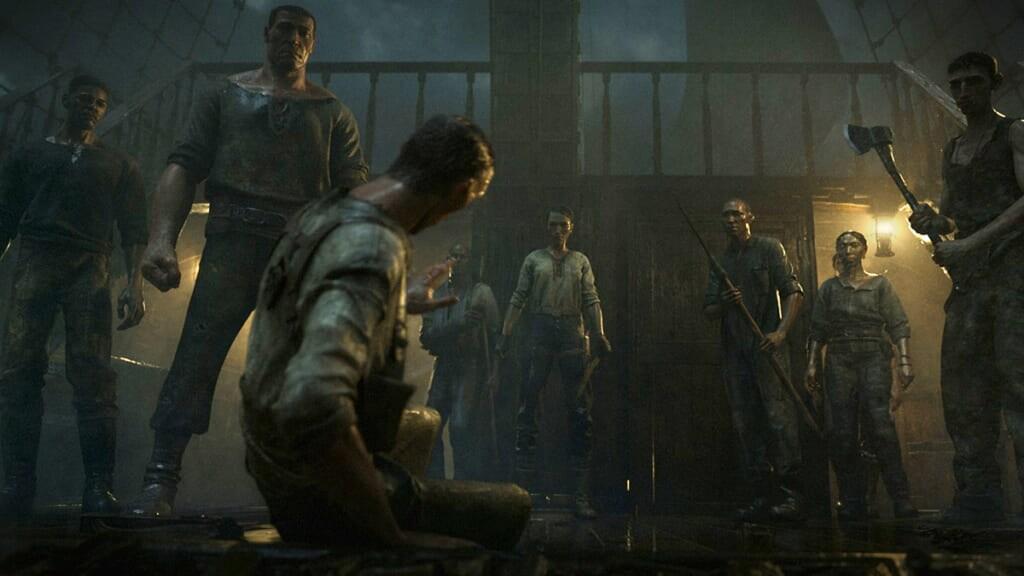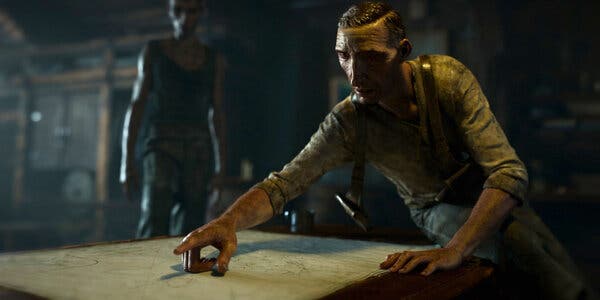The director and the writer of “Seven” are back in the saddle again for this wild and disgusting short movie.
Genre: Fantasy/Period
Premise: A ship sailing through the ocean is boarded by a giant man-eating crab that demands to be taken to a highly populated island where it can feast to its heart’s content.
About: David Fincher! Andrew Kevin Walker! You can watch this short film right now on Netflix’s 3rd season of Love, Death, and Robots!
Writer: Andrew Kevin Walker (adapted from short story by Neal Asher)
Details: 21 minutes

You wonder why it took these two – Walker and Fincher – so long to reconnect. They’re making that assassin film, “The Killer,” with Michael Fassbender. I guess this is their warm-up before the big match. And boy what a warm-up it is.
I haven’t watched all of the Love, Death and Robots episodes from Season 3 yet. But what I can tell you from watching this season’s current promotional title, Jibaro, and episodes from previous seasons, is that the creators continue to make the same mistake, which is that they use the medium as a way to play with toys, not tell stories.
Jibaro, which follows a group of 17th century soldiers who get attacked by an evil water nymph, isn’t bad. But all you have to do is watch Bad Traveling to see why Fincher is so far ahead of these other guys. Sure, Fincher likes to play with toys as well. But he understands that, at the end of the day, if we aren’t emotionally connected to the characters, and there isn’t a compelling story at the center of the movie, and that story isn’t structured properly to build suspense, engage in conflict, then pay off everything that’s been set up, then you’re just @$%&ing around.
This latest story of his plays with one of the most powerful tools available to a storyteller. I’ll tell you what that is right after I summarize the plot…
Presumably set several centuries ago, a sea ship is attacked by a giant crab-like monster. After killing the captain of the ship, the crab burrows its way into the ship’s hull. The ship members draw straws on who has to go down there and face this thing to figure out what it wants.
A Machiavellian crew member named Torrin draws the short straw, goes down to the crab, who, through the voice of one of the killed crew members, explains that he wants to be taken to a specific island that is full people so that he can feast to his heart’s desire.
Torrin, who has now claimed captain’s status, relays this demand to the rest of the crew but suggests an alternative. They take Crabby to a decoy unpopulated island, one he’d be none the wiser about, to save the innocent people of the first island.
The crew isn’t sure. If the crab figures out what they’re doing, he might eat all of them up. So Torrin decides to put it to a silent vote. He hands out pieces of paper and everyone anonymously votes which island to send the monster to. Torrin then informs them that he tricked them, secretly marking each scrap of paper so that he knew who the cowards were, aka, the people voting to send the crab to the populated island.
Torrin shoots those two cowardly voters dead.
The trip to their destination will take a day and a half, which poses a big problem. Crabby is VERY HUNGRY. He needs feeding every few hours. Which means that decisions will have to be made on which members get picked for feeding time. As the trip draws to a close, Torrin will make a dangerous decision that will determine who gets off this boat alive: him, or that darn crab.

This was a REALLY good short film, guys.
All short film directors and writers need to study it because, like I said, it wasn’t just about the toys. It’s about a great story with a clear beginning (set up the problem that leads to the objective), middle (complications arise which make achieving the objective difficult), and end (they either achieve the objective or fail).
But what really stands out to me about this story is the focus on a very powerful writing tool: CHOICE.
You want to put your characters into multiple situations where they have a CHOICE to make. The more difficult the choice is, and the bigger the stakes are attached to that choice, the more entertaining that plot point is going to be.
One of the first CHOICES in Bad Traveling is, who’s going to go down and see what the crab wants? Note how big the stakes attached to this choice are. Whoever gets picked to go down there is very likely going to be killed. They just saw this thing massacre half their crew.
Next up, they learn that this thing needs to be constantly fed. Which means they need a body to feed to it right away. That’s the next choice. Who’s going to be the meal? Note how the stakes to this choice are even higher than the previous one! Cause this person is definitely dying.
Next up, we have the choice of which island to go to – the populated or unpopulated one. This choice brings with it more complexity. The decoy island is further away. Which means more crew members will have to be fed to this monster if they choose this route. Also, there’s a moral twist to the choice. You can save yourself but kill others by choosing the populated island. Or save others and risk your life if you choose the decoy island.
That’s when “choice” becomes really interesting in storytelling – when there aren’t easy answers, when there are more than a single element attached to the choice.
I’m telling you, if you want to write a good scene in the screenplay you’re working on right now, come up with a scenario where your characters have to make a difficult choice and there are high stakes attached to that choice, and everybody’s decision affects everybody else. You’re getting a lot of storytelling bang for your buck out of that scenario.
In addition to Bad Travelling being a great lesson on “choice” in writing, it’s just a great script in general. One of the ways I can tell that the writer did his job is when we encounter a common scenario and the writer has found a way to explore that scenario beyond its obvious outcome.
For example, when they take the votes for which island to go to. Traditionally, these scenes end with the orchestrator reading the votes and informing everyone else of the decision. But Andrew Kevin Walker took this scenario one step further by having Torrin inform everyone that he’d secretly marked each piece of paper to weed out the cowards. Any time you can take a trope and expand it into something new or unexpected, you’re doing your job as a screenwriter. If you’re always taking those moments to their expected logical conclusions, your writing is never going to shine.
The team even got the basics right. There’s a heavy ticking time bomb here since this monster needs to be fed. Every delay has the potential to take another life. Which means the story moves along quickly. They also introduce complications. No pursuit should ever be simple. So at one point, the crew tries to kill the captain, which he fights off and survives.
All around, this is a great short film on its own merit, as well as a great short for screenwriters to study. I loved it.
[ ] What the hell did I just read?
[ ] wasn’t for me
[ ] worth the read
[x] impressive
[ ] genius
What I learned: The double-twist. Why get single mileage out of a twist when you can get double mileage! Spoilers: Torrin reveals after the vote that he tricked the crew to weed out the cowards. He then kills the two cowards. Later, when Torrin is with his closest confidant, he tells him he lied about the voting. It wasn’t two crew members who voted for the cowardly option. It was all of them. He then pushes the confidant (the last crew member besides himself) through a hole on the deck, where he falls into the crab’s feeding room.

